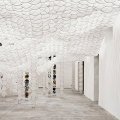The San Bushmen, the original nomadic peoples of Southern Africa believed in the concept of “Thinking Strings,” ropes of consciousness that linked them with the divine. They believed that under trance it was possible for the shaman to ascend to the heavens upon these ropes like the Biblical account of Jacob’s ladder. On the 24 February 1969 Johnny Cash “Walked the Line” for his love in front of an audience of prisoners at San Quentin State Prison and in 1986 post-punk group Alien Sex Fiend walked “the line between good and evil.” Deleuze and Guattari, refused to translate their concept “Ligne de Fuite” out from French in fear that it may be lost in translation, for it is as much about leakage and escape as it is about flight and fleeing.
“Ligne de Fuite 9025” respects the French philosophic fears, but acknowledges the contradictions of reading that a work of art demands. The number 9025 has been randomly generated by jpeg number that my digital camera has assigned the image by chance, cast upon its first shooting. I say that knowing that there is in fact no such thing as chance as everything is interconnected with everything else in a pataphysical universe of exceptions and what we read as chaos is simply our inability to join the dots in order to form a line of logic.
Cast into a deep depression brought upon by the inequities of an art system that cares little for anything other than market and ranking, I found myself seeking other ways of seeing and other forms of creation through other modes of expression. Having witnessed more than a few artists receiving undue recognition (and significant reward) for the languages and modes of creation that I had dragged kicking and screaming into the white cube two decades ago, I felt abandoned by a system and found my self surrendering to a more profound nature. Deep from within the recesses of my imagination I heard a calling, a voice that sounded like William Blake’s, a voice that demanded of me that I open the doors of my perception. I surrendered to the calling and witnessed the birth of a series of paintings known as “Ligne de Fuite”
The ancient shamanic thinking strings wove their magic through my intellect and French Philosophy found itself at the cross stitch of good and evil. “Ligne de Fuite” saved my life for it was a beacon of light through which I could enter a space that until that precise moment I could never have even imag-ined. I understood that in order to see further I had to close my eyes for the way out lay within. “Ligne de Fuite” was not painted so much as revealed, a pataphysical process of allowing nature to find its place within the natures that I am surround by.
I found my way all the way back to where it all began. For the world it is known by the name Razormesh, (N.A.T.O. WIRE in Germany) but for me it will always be the sign of my childhood, the symbol of my nation, the curse of my ancestors, the military technology spawned by the crime against humanity known as Apartheid. Invented and patented in South Africa, Razormesh now defines every border on the planet, disguising its origins through a rhizomic network of blades that cut through every airport, military installation, power station all the way through to the Eurostar platforms at the heart of Gare du Nord in Paris. It may be said that Razormesh is the protégé heir to the “Devil’s Rope” as barbed wire has been called. Whilst it is true that in today’s world, Razormesh is for humans and Barbed Wire for Cattle, that was not always the case. The first time that Barbed Wire was used as a military weapon was, not without coincidence, again in South Africa, used by the British during the Second Anglo Boer War of 1899, to incarcerate prisoners of war in the world’s first concentration camps. Only a few decades later concentration camps and barbed wire would become synonymous with the worst atrocities ever committed by one human being against another.
“Ligne de Fuite 9025” recalls my identity, records the history of blood, and the blood of history that runs through my veins. I am the child of Apartheid, the run-away kid who could never escape from his own blood. The sharp blades of my childhood have slashed open a path through the flesh of my cultural heritage into the abyss. The two cultural circles of my ancestors, the Dutch and the British overlap to form the mandorla, a third space, the Afrikaans blood that I was born with. “The Country of my Skull” is marked with pain and trauma as much as with truth and contradiction. I am both African and European and yet neither.
It would be impossible to read a work of art like “Ligne de Fuite 9025” without first being introduced to the Socio-Political Frankenstein that I am. The darkness that surrounds the portal of blood is not a metaphor, but my reality. The chaos that refuses reading is my cross to bear. Art called me out from Apartheid Military Service and Art guided me through a time of revolution and it was through Art that I was able to forge a new morality, a new identity and find a way out from the curse of having been born into a political system that I was dead against. Finally, once I had given upon everything, given up on art as well as myself and cast into the deepest darkness of depression, it was Art that once more time showed me another way.
The canvas is stretched tight across the frame like the shamanic drum, softly vibrating, quietly emanating. The supporting cross is hidden behind the canvas, marking the intersection between our physical world and the vertical worlds of spirit. I had always imagined myself to be the enemy of painting, but having been broken up and devoured by a system drunk with power and inebriated by profit, my enemy caressed my soul and gave me an unknown comfort.
The line that I walk is between the known and the unknown, between that which I can control and my losing control. Like the snail in Apocalypse Now, the line I walk is the sharp edge of the razorblade, between the worlds of form and chaos, between flesh and spirit, between language and virus. The blade of history cuts me every time I try to move, but without movement I fear that one day I may just find myself back in the darkness that nurtured me. The world of spirit called me from the other side of the canvas, revealing a path through my history, a line of flight into the unknown, a “ligne de fuite” that connects me to my bleeding history, as well as to yours, the interconnectedness of our socio-political networks mapped out as they are, scars.































